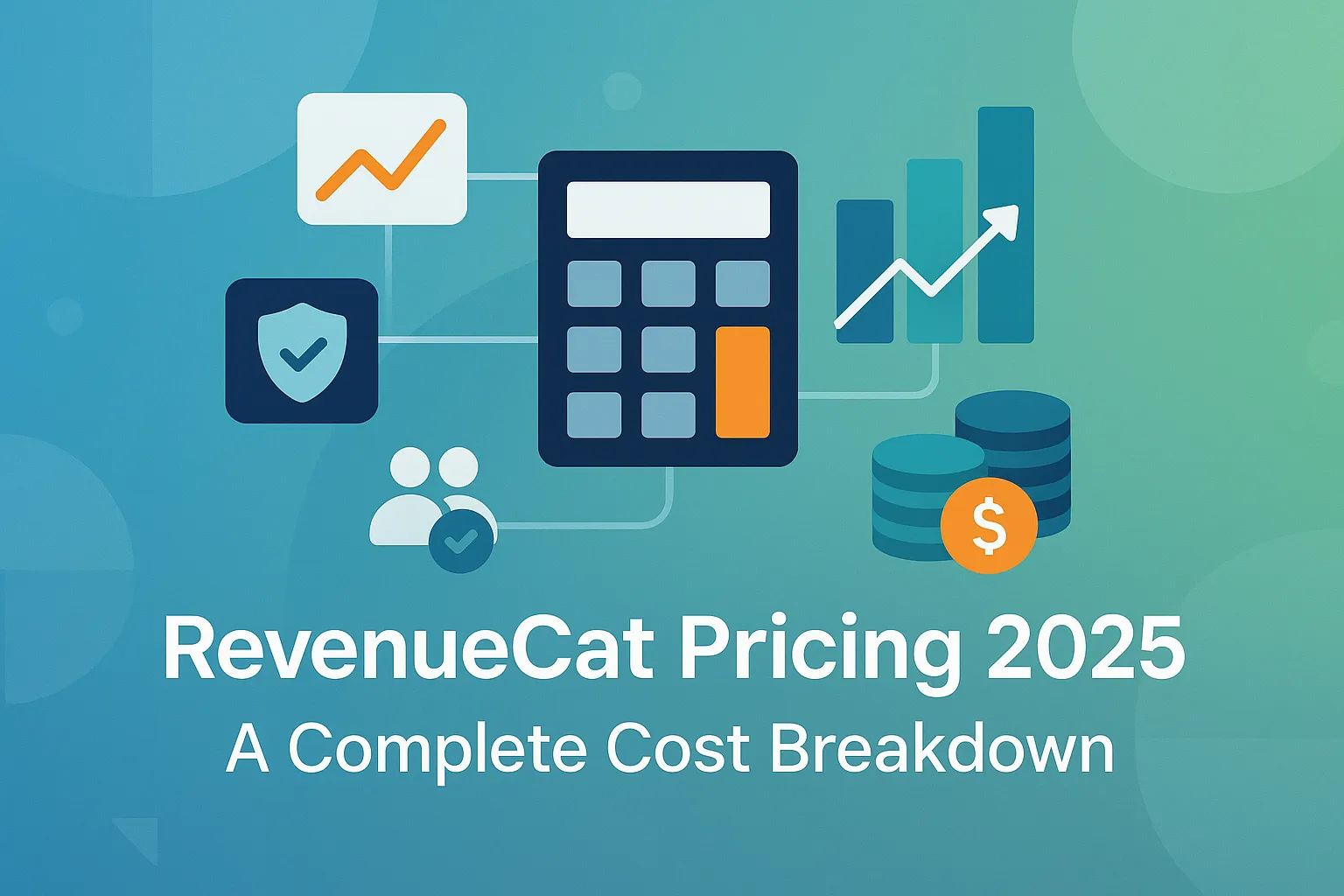If you’re building an app with in-app purchases, you’ve almost certainly come across RevenueCat. It’s a powerful tool that simplifies subscriptions and backend receipt validation. But a common question we hear from founders is: “How much does RevenueCat actually cost?”
While RevenueCat has a generous free plan, understanding its pricing tiers is crucial for forecasting your app’s operational expenses as you grow. A pricing model based on Monthly Tracked Revenue (MTR) can be confusing, and there are often costs beyond the sticker price.
This guide breaks down RevenueCat’s complete pricing structure for 2025, from the free tier to the enterprise plan, so you can make an informed decision.
What is RevenueCat? An In-Depth Look
Before diving into the numbers, let’s quickly recap what RevenueCat does. It’s a backend-as-a-service (BaaS) platform specifically for in-app purchases and subscriptions. It provides a reliable server infrastructure to:
- Validate Receipts: Securely validates every purchase receipt with the App Store and Google Play to prevent fraud and ensure data accuracy.
- Manage Subscription Status: Tracks the complete subscription lifecycle for every user, including trials, renewals, cancellations, and billing issues (dunning). This creates a single source of truth for user entitlements.
- Provide Analytics: Offers powerful charts and dashboards to monitor key metrics like Monthly Recurring Revenue (MRR), churn rate, Lifetime Value (LTV), and trial conversion rates.
- Integrate with Your Stack: Pushes real-time purchase data to third-party tools like Mixpanel, Amplitude, Adjust, and CRMs, enriching your user data across platforms.
Essentially, RevenueCat handles the complex and time-consuming backend logic of in-app purchases, allowing you to focus on building your app. If you want a deeper dive, check out our RevenueCat technology overview.
A Deeper Dive into RevenueCat’s Pricing Model
RevenueCat’s pricing is based on your app’s Monthly Tracked Revenue (MTR). This is the revenue your app processes through the App Store and Google Play before Apple or Google take their commission. This is a critical point of confusion for many developers.
Let’s walk through an example:
- Your app has 1,000 subscribers, each paying $9.99 per month.
- Your gross revenue for the month is 1,000 * $9.99 = $9,990.
- Apple/Google takes their commission (let’s say 15%), which is $1,498.50.
- Your net payout from the app stores is $8,491.50.
RevenueCat’s fee is calculated based on the $9,990 gross revenue, not your net payout. In this scenario, your MTR is just under the $10,000 threshold, so you would be on the Starter Plan. Understanding this distinction is key, and it’s a detail we always clarify when helping our clients build their financial models during our mobile app development projects.

How RevenueCat Calculates Your MTR Infographic
Designer Instructions
Create a simple, clear flowchart that explains how Monthly Tracked Revenue (MTR) is calculated. Start with a user paying $9.99 in the app. Show arrows pointing to: 'Gross App Revenue: $9.99', then 'Apple/Google Commission (e.g., -$1.50)', then 'Your Payout: $8.49'. Add a large label pointing to the Gross App Revenue box stating: 'This is the number RevenueCat uses to calculate your MTR.'
RevenueCat Pricing Tiers 2025
Here’s a breakdown of the plans:
| Feature | Free | Starter | Pro | Enterprise |
|---|---|---|---|---|
| Price | $0 | Starts at $8/mo per $1,000 MTR | Starts at $12/mo per $1,000 MTR | Custom Pricing |
| MTR Limit | Up to $2,500 / mo | $2,500 - $10,000 / mo | Over $10,000 / mo | For large-scale apps |
| Core Features | ✅ | ✅ | ✅ | ✅ |
| Integrations | ✅ (Basic) | ✅ (All) | ✅ (All) | ✅ (All) |
| Charts/Analytics | ✅ (Basic) | ✅ (Advanced) | ✅ (Advanced) | ✅ (Advanced) |
| Experiments | ❌ | ✅ | ✅ | ✅ |
| Support | Community | Priority Email | Dedicated Support & SLA | |
| User Limit | Unlimited | Unlimited | Unlimited | Unlimited |
The Free Plan: Perfect for Getting Started
For new apps or those earning less than $2,500 per month, the Free plan is incredibly generous. It gives you access to all the core functionality needed to launch and manage in-app purchases. You can stay on this plan forever as long as your MTR is below the threshold.
The Starter Plan: For Growing Apps
Once your app’s MTR crosses $2,500, you’ll move to the Starter plan. The pricing is usage-based, costing $8 per month for every $1,000 in MTR. This plan unlocks all integrations and advanced charting features, which are essential for understanding your revenue growth.
The Pro Plan: For Scaling Businesses
For apps with over $10,000 in MTR, the Pro plan offers more advanced features and priority support. The cost increases to $12 per month per $1,000 MTR, reflecting the need for more robust support and tooling as your revenue scales.

RevenueCat Pricing Tiers at a Glance Infographic
Designer Instructions
Create a side-by-side visual comparison of the Free, Starter, and Pro plans. Use columns for each plan with icons and checkmarks to show which features are included (e.g., a check for 'Advanced Charts' in Starter/Pro, an 'X' in Free). Use large, clear fonts for the price and MTR threshold for each plan. Goal: Make the core pricing information scannable and easy to digest in under 10 seconds.
Beyond the Sticker Price: The “Hidden” Costs of RevenueCat
While the pricing tiers are straightforward, the total cost of ownership involves more than just the monthly subscription. At MetaCTO, we help clients evaluate these factors to build a realistic budget.
1. Implementation & Development Costs
While RevenueCat simplifies the backend, you still need skilled developers to integrate its SDK into your app. This involves:
- Initial Setup: Configuring the SDK, setting up entitlements, and testing purchase flows.
- Paywall UI/UX: Designing and building a high-converting paywall screen.
- Ongoing Maintenance: Updating the SDK and adapting to any changes from Apple or Google.
If your team is new to this, it can take significant time. This is where partnering with a specialized mobile app development company can accelerate your timeline and prevent costly mistakes.
2. The Cost of Inaction (Building In-House)
The most significant “hidden cost” is often the opportunity cost of not using a tool like RevenueCat. Building, testing, and maintaining your own in-app purchase server is a massive undertaking. It requires:
- Deep expertise in server-side receipt validation for both iOS and Android.
- 24/7 server maintenance and on-call support for outages.
- Constant updates to keep pace with platform changes.
This diverts your engineering team from focusing on core app features that drive user value. Our Fractional CTO service often advises startups that building this in-house is rarely cost-effective until you reach a massive scale.
3. Migration and Switching Costs
If you already have an in-app purchase system, migrating to RevenueCat involves its own set of costs. You’ll need a clear data migration plan to move existing subscriber data without interrupting service. This can be a complex project, especially for apps with a large user base. Our Project Rescue team often helps companies navigate these tricky transitions.

Build vs Buy: The Real Cost of In-App Purchase Infrastructure Infographic
Designer Instructions
Create a decision-tree or two-sided scale infographic comparing the costs and responsibilities of using RevenueCat versus building an in-house solution. RevenueCat Side: Show a simple list: 'Monthly Subscription Fee,' 'One-time SDK Integration.' In-House Side: Show a much longer, complex list: 'Server Hosting Costs,' 'Backend Developer Salaries,' '24/7 On-Call Support,' 'Database Management,' 'Security Audits,' 'Constant API Updates.' Goal: Visually demonstrate the immense complexity and cost of the in-house option.
RevenueCat Alternatives: A Brief Comparison
While RevenueCat is a market leader, it’s not the only option. Here are a few alternatives to consider:
- Adapty: A close competitor with a similar feature set. Adapty’s pricing is also based on MTR but with slightly different tiers. It’s known for its strong A/B testing and paywall-building features.
- Qonversion: Another strong alternative that offers robust A/B testing and remote config capabilities. Qonversion’s pricing is also MTR-based, making it a direct competitor.
- In-House Solution: As discussed, this offers the most control but comes with the highest cost and complexity. It’s generally only recommended for very large companies with dedicated engineering teams.
Choosing the right platform—or deciding to build in-house—is a critical technical and business decision. At MetaCTO, we provide unbiased guidance as part of our Fractional CTO services to help you make the most cost-effective choice for your specific situation.
Need RevenueCat Integration Help?
Don't risk your subscription revenue on a poor implementation. Our mobile experts can help you integrate RevenueCat correctly and optimize your monetization strategy.
Is RevenueCat Worth The Cost? A Deeper Analysis
For 99% of apps, the answer is a resounding yes. The return on investment (ROI) for RevenueCat extends far beyond just saving developer time.
- Increased Revenue: By providing reliable infrastructure, RevenueCat reduces the chance of lost sales due to technical glitches. Its analytics also help you identify opportunities to optimize your pricing and paywalls, directly impacting your bottom line. Our app growth services focus on leveraging tools like RevenueCat to turn analytics into actionable revenue strategies.
- Reduced Churn: RevenueCat’s dunning management features help to recover failed payments, reducing involuntary churn. The platform’s stability also improves the user experience, leading to higher retention.
- Faster Time-to-Market: For new apps, RevenueCat can shave weeks or even months off your development timeline. This speed is a critical advantage in a competitive market and is a cornerstone of our monetization services.
When you factor in these benefits, the cost of RevenueCat becomes a small price to pay for a robust, scalable, and revenue-generating subscription infrastructure.
Frequently Asked Questions
Is RevenueCat really free?
Yes, RevenueCat is completely free for apps that generate less than $2,500 in Monthly Tracked Revenue (MTR). The free plan includes all core features needed to launch and manage in-app purchases.
How is RevenueCat's Monthly Tracked Revenue (MTR) calculated?
MTR is the total amount of money your app processes through the App Store and Google Play *before* Apple and Google take their 15-30% commission. For example, if you sell a $10 subscription, the full $10 counts towards your MTR.
What are the main alternatives to RevenueCat?
The main competitors to RevenueCat are Adapty, Qonversion, and Nami ML. Each has slightly different features and pricing models. The other major alternative is building and maintaining your own in-house subscription server, which is a significant engineering commitment.
Does RevenueCat work with Stripe?
Yes, RevenueCat has an integration with Stripe for web-based payments. This allows you to manage both mobile and web subscriptions in one place, providing a unified view of your customers.
Conclusion: A Smart Investment in Your App’s Future
Understanding RevenueCat’s pricing is key to managing your app’s financial health. While it’s not just a “set it and forget it” solution, its value far outweighs the costs for most publishers. The platform handles the complex, undifferentiated heavy lifting of in-app purchases, freeing you to focus on what truly matters: building an amazing app that users love and are willing to pay for.
Ready to implement a rock-solid monetization strategy for your app?
The team at MetaCTO has extensive experience with RevenueCat and in-app subscription models. Whether you’re building a new app or need to rescue an existing project, we can help.
➡️ Explore our Monetization Services to see how we can help you grow your revenue.

